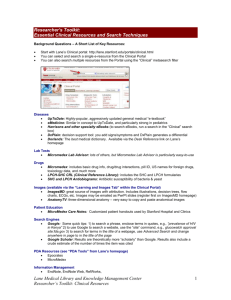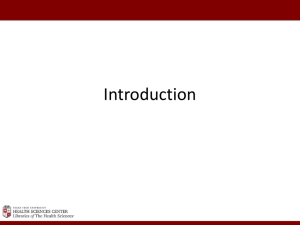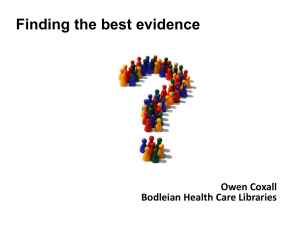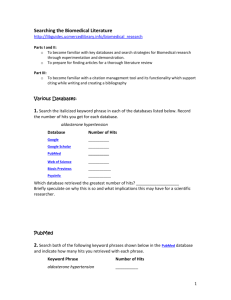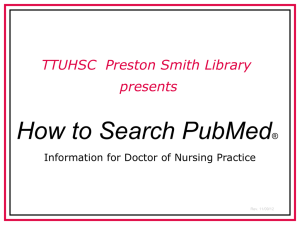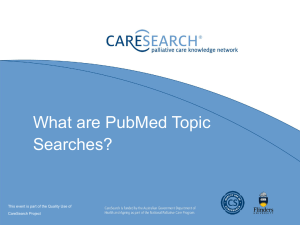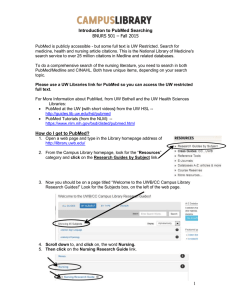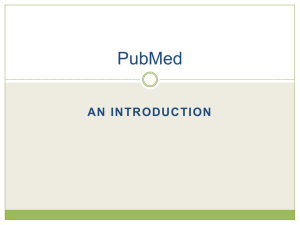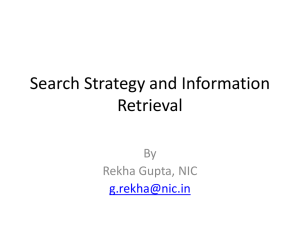PubMed Tutorial
advertisement
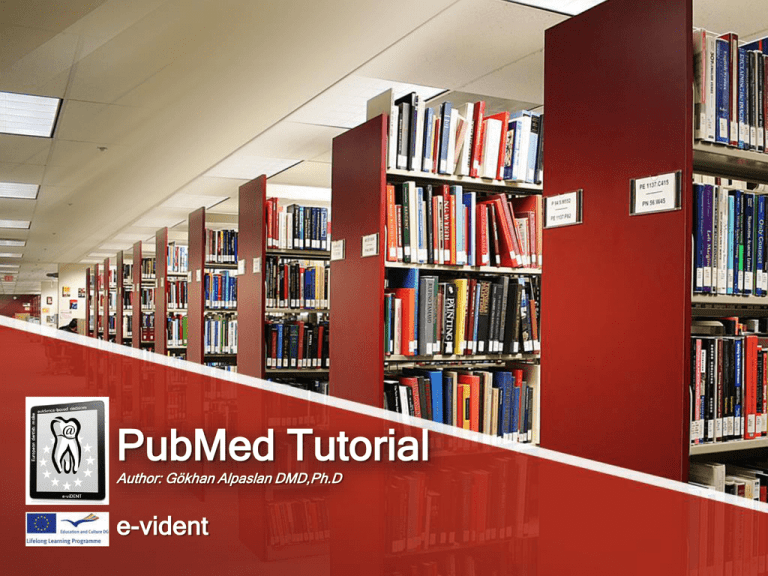
PubMed Tutorial Author: Gökhan Alpaslan DMD,Ph.D e-vident Objectives Introducing Practitioner PubMed Searching for Systematic Reviews Combining earch Terms MeSH Search Outline What is PubMed Searching Clinical Queries PICO Model PubMed Search Logic of Boolean Combining Search Terms What is MeSH MeSH Search References Outcome Practitioner will; Know Search Tools Construct PICO model Combine Search Terms Able to Search in PubMed Search Engine PICO Model PICO or PECO is an acronym used to identify four primary components of a well formulated clinical question. P I C O = = = = Patient Population or Problem Intervention or Exposure Comparison Outcome PubMed http://www.ncbi.nlm.nih.gov What is PubMed Produced by NCBI, PubMed is part of the Entrez retrieval system of related biomolecular databases PubMed includes MEDLINE, a premier NLM biomedical database of worldwide journal literature in medicine, nursing, dentistry, veterinary medicine, public health and the preclinical sciences PubMed is an excellent database for finding some articles on most health/medicine topics. PubMed citations come from more than 5,000 biomedical journals. PubMed has more than 21 million citations from the 1940's to the present. PubMed includes very recent articles and updated each week. Coverage is current as participating publishers submit electronic citations daily PubMed is free to anyone with internet access. PubMed includes links to full text at publisher or library web sites Combining similar terms Use Boolean operators to combine different terms OR use to combine different terms for the same concept AND to combine different concepts NOT excludes concepts but must be used with caution to avoid excluding relevant items Search limits Consider search refinements to limit to specific aspects of a topic, such as: Meta-Analysis (quantitative summary combining results of independent studies) human or animal studies male or female subjects age groups, for example adolescents, infants time periods languages Sample Case Scenario; PICO Model P Problem/Patient I Intervention C Comparison O Outcome A patient has prescribed Zometa and referred to your office by a fellow oncologist. Patient admitted to your office for his/her dental treatment. Some teeth need to be extracted, periodontal and endodontic treatment as well. Finally prosthetic rehabilitation planned. You are aware of Zometa related osteonecrotic lesions of the jaw bones following dental interventions like tooth extraction. Is there a dental treatment guideline and what is the best evidence based treatment option for patients under biphosphanates. Logic of Boolean OR will search for articles containing any of the terms we chose. Use OR to combine synonyms, alterative spellings or related items AND will search for articles which contain all of the terms we have chosen. Before starting search consider; The keywords Other ways to spell the keywords Other words which mean the same thing (synonyms) Related keywords need to be included Limits to apply: date, language, age group, publication type By adding terms and combining them with apropriate boolean practitioner will refine search. In this particular example combining terms “zometa”, “dental treatment”, “guidelines combined by AND. Therefore, the practitioner retrieved 4 systematic reviews. MeSH Medical Subject Headings MeSH is the standard terminology used by the indexer and helps to find articles on the topic, regardless of the exact wording used by the authors. Controlled vocabulary of subject terms; it is another feature built into PubMed to enhance retrieval of best evidence. What is MeSH? MeSH is a vocabulary of subject headings and subheadings Subject terms are selected and approved for use by NLM Each year subject headings are revised with additions and deletions Scope note indicate what is meant by the term Used to describe the subject content of all publication types in PubMed and in the library catalogs Hierarchy of terms with broad and narrow terms Items are indexed with the most specific MeSH term available Advantages of MeSH • Consistency in meaning of terms is maintained over time • Synonyms are organized under one MeSH term • Allows for both specific and comprehensive results • Cuts down on irrelevant retrieval The MeSH controlled vocabulary is a distinctive feature of MEDLINE. It imposes uniformity and consistency to the indexing of biomedical literature. MeSH terms are arranged in a hierarchical categorized manner called MeSH Tree Structures and are updated annually. Searching using MeSH allows you to overcome problems of spelling and terminology; especially when you might not be aware of different spellings or terminology. Click on the term to view full record and access PubMed search options for additional information. Click to add to search builder Subheadings describe specific aspects of the subject. Click if apropriate. Tick out the appropriate box to broaden or narrow the search for your interest Practitioner easily retrieved a guideline for dental treatment in patients on bisphosphanates by implementing appropriate search terms in a short time in MeSH. References 1. 2. 3. 4. 5. 6. Elliot Abt; The Basics of Evidence Based Dentistry ADA Policy on Evidence Based Dentistry Sutherland S.; J Can Dent Assoc 2001; 67:204-6 McQuay HJ, Moore RA; Evidence-based resource for pain relief. Oxford:Oxford University Press, 1988. Sackett DL, Rosenberg WM, Gray JA, Haynes RB, Richardson WS; Evidence based medicine: what it is and what it isn't. BMJ. 1996;312:71–72. UT Health Science Center; Oral Health Information Tutorial for Dental Public Heath Professionals.



